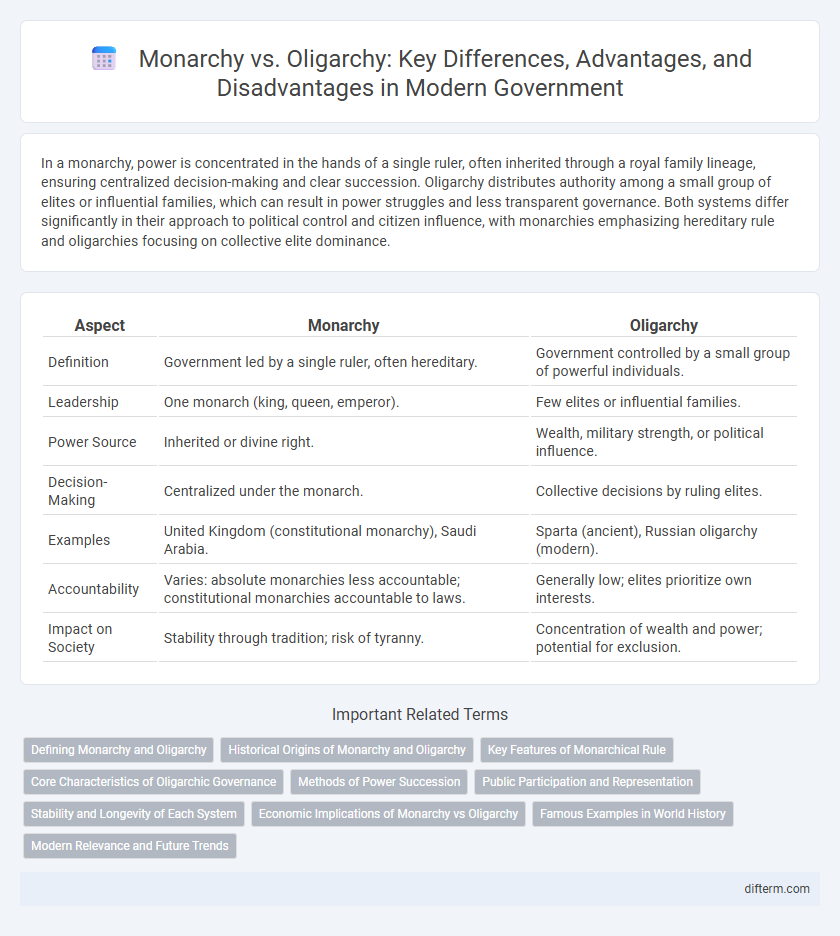In a monarchy, power is concentrated in the hands of a single ruler, often inherited through a royal family lineage, ensuring centralized decision-making and clear succession. Oligarchy distributes authority among a small group of elites or influential families, which can result in power struggles and less transparent governance. Both systems differ significantly in their approach to political control and citizen influence, with monarchies emphasizing hereditary rule and oligarchies focusing on collective elite dominance.
Table of Comparison
| Aspect | Monarchy | Oligarchy |
|---|---|---|
| Definition | Government led by a single ruler, often hereditary. | Government controlled by a small group of powerful individuals. |
| Leadership | One monarch (king, queen, emperor). | Few elites or influential families. |
| Power Source | Inherited or divine right. | Wealth, military strength, or political influence. |
| Decision-Making | Centralized under the monarch. | Collective decisions by ruling elites. |
| Examples | United Kingdom (constitutional monarchy), Saudi Arabia. | Sparta (ancient), Russian oligarchy (modern). |
| Accountability | Varies: absolute monarchies less accountable; constitutional monarchies accountable to laws. | Generally low; elites prioritize own interests. |
| Impact on Society | Stability through tradition; risk of tyranny. | Concentration of wealth and power; potential for exclusion. |
Defining Monarchy and Oligarchy
Monarchy is a form of government where a single individual, typically called a king or queen, holds supreme authority, often inherited through a royal lineage. Oligarchy involves governance by a small group of powerful individuals who control decisions and policies, usually based on wealth, family, or military strength. Both systems contrast with democratic governance by concentrating power within a limited number of people.
Historical Origins of Monarchy and Oligarchy
Monarchy originated in ancient civilizations where a single ruler, often claiming divine right, centralized power to maintain order and legitimize authority. Oligarchy emerged as rule by a small, privileged group, typically aristocrats or wealthy elites, who dominated political decisions for economic or social advantage. Both systems evolved in response to societal needs for governance but reflected fundamentally different power distributions and legitimacy sources.
Key Features of Monarchical Rule
Monarchical rule is characterized by centralized authority vested in a single sovereign, often hereditary, who holds supreme political power. This system typically features a clear line of succession, enabling continuity and stability within the government structure. Monarchs may exercise absolute control or share power through constitutional frameworks, influencing legislative, executive, and judicial functions.
Core Characteristics of Oligarchic Governance
Oligarchic governance centralizes power among a small, elite group that controls key political and economic resources, often prioritizing their interests over public welfare. This concentration of authority results in limited political pluralism and restricted citizen participation in decision-making processes. The ruling minority typically exercises influence through wealth, social status, or military control, maintaining power via networks of patronage and exclusionary policies.
Methods of Power Succession
Monarchy relies on hereditary succession, where power is typically passed down within a royal family according to established lineage rules, often primogeniture. In contrast, oligarchy features power succession through a limited group of elites, with leadership transferred based on elite consensus, internal selection, or force rather than popular vote. These distinct methods influence political stability and governance structures within each system.
Public Participation and Representation
Monarchy centralizes authority in a single ruler, often limiting public participation and reducing direct representation in governance decisions. Oligarchy concentrates power within a small group, which may allow for some representation but frequently excludes broader citizen input and restricts democratic engagement. Public participation is generally more constrained in both systems compared to democratic forms that prioritize widespread representation and inclusive decision-making.
Stability and Longevity of Each System
Monarchies often achieve long-term stability through centralized authority and hereditary succession, which can create continuity and predictable governance. Oligarchies may experience fluctuating stability as power struggles among elite groups lead to internal conflicts and policy inconsistency. Historical examples demonstrate monarchies like the British Crown enduring for centuries, while oligarchies such as the Venetian Republic maintained relative stability but often faced challenges from competing factions.
Economic Implications of Monarchy vs Oligarchy
Monarchies often centralize economic control in the hands of a single ruler, potentially leading to stable but rigid economic policies that favor long-term investments and elite wealth preservation. Oligarchies distribute economic power among a small group of influential individuals or families, which can drive aggressive economic competition but also exacerbate wealth inequality and limit broader economic participation. Both systems risk prioritizing elite interests over equitable economic development, affecting market dynamics, resource allocation, and social welfare policies.
Famous Examples in World History
The British monarchy exemplifies a long-standing constitutional monarchy where the monarch's powers are limited by law, blending tradition with parliamentary governance. In contrast, ancient Sparta represents a classic oligarchy, ruled by a small group of elite warriors and elders who held political and military control. Both systems highlight distinct approaches to governance with monarchy centering power in a single ruler while oligarchy distributes authority among a select few.
Modern Relevance and Future Trends
Modern relevance of monarchy centers on constitutional forms, where symbolic power coexists with democratic governance, preserving cultural heritage while limiting political authority. Oligarchy manifests in contemporary corporate and political elite dominance, influencing policy through concentrated wealth and networks. Future trends suggest increasing scrutiny of oligarchic power amid demands for transparency, whereas constitutional monarchies may evolve by enhancing participatory roles within democratic frameworks.
Monarchy vs Oligarchy Infographic

 difterm.com
difterm.com